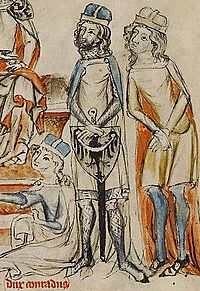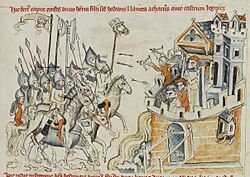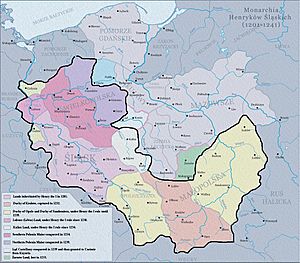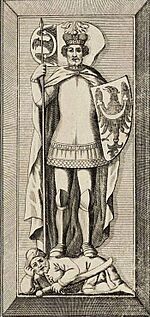Henry II the Pious facts for kids
Quick facts for kids Henry II the Pious |
|
|---|---|

Henry II (center) holding a shield with the crest of Silesia, Hedwig Codex, c. 1353
|
|
| High Duke of Poland | |
| Reign | 1238–1241 |
| Predecessor | Henry I the Bearded |
| Successor | Konrad I of Masovia |
| Duke of Silesia | |
| Reign | 1238–1241 |
| Predecessor | Henry I the Bearded |
| Successor | Bolesław II the Bald |
| Born | c. 1196 |
| Died | 9 April 1241 (aged 44-45) Legnickie Pole |
| Burial | St Vincent's Church, Wrocław |
| Spouse | Anne of Bohemia |
| Issue | Constance of Wrocław Bolesław II the Horned Mieszko of Lubusz Henry III the White Konrad I of Głogów Elisabeth of Wrocław Ladislaus of Salzburg |
| House | Silesian Piasts |
| Father | Henry I the Bearded |
| Mother | Hedwig of Andechs |
Henry II the Pious (Polish: Henryk II Pobożny) was an important ruler in Poland. He was born around 1196 and died on April 9, 1241. From 1238 until his death, he was the Duke of Silesia and the High Duke of Poland. He also ruled parts of Greater Poland. For a short time, he acted as a regent (a person who governs for a young ruler) for other areas like Sandomierz. Henry was the son of Henry the Bearded and belonged to the Piast family. In 2015, the Church began a process to recognize him as a saint.
Contents
Early Life and Rise to Power
Henry the Pious was the second son of High Duke Henry the Bearded and Hedwig of Andechs. His older brother, Bolesław, passed away in 1206. In 1213, his younger brother Konrad also died during a hunt. This made Henry the only heir to his father's lands in Lower Silesia.
Around 1218, his father arranged for Henry to marry Anne. She was the daughter of King Ottokar I of Bohemia. This marriage connected Henry to the powerful Přemyslid dynasty. It helped him take part in important international politics.
Becoming Co-Ruler
Henry the Bearded quickly made his only surviving son his main heir. From 1222, young Henry began to sign official documents with his father. By 1224, he even had his own official seal and a notary (a legal assistant).
In 1227, something dangerous happened. During a meeting of Polish dukes, Henry the Bearded was attacked. The High Duke at the time, Leszek I the White, was killed. Henry the Bearded was badly hurt. Young Henry the Pious stepped in as the temporary duke.
Later, in 1229, Henry the Bearded was captured by Duke Konrad I of Masovia. Again, Henry the Pious took over as temporary ruler. He led a military trip to secure the Lubusz Land in 1229–1230. He also helped his father in Prussia and Greater Poland from 1233–1234.
In 1234, Henry the Bearded officially made his son a co-ruler. Henry the Bearded kept the duchies of Kraków and Silesia. Henry the Pious was given the duchies of Silesia and Greater Poland. When his father died in 1238, Henry the Pious became the sole Duke of Silesia, Kraków, and Greater Poland.
Henry's Rule as Duke
Henry the Pious inherited Lower Silesia from his father. He also gained control over Southern Greater Poland and Kraków. These lands were supposed to go to Henry the Bearded after the previous duke, Władysław III Spindleshanks, died. However, other dukes like Konrad of Masovia did not agree.
Henry II was able to keep his power as a regent over the Duchy of Opole-Racibórz. He also ruled the Duchy of Sandomierz. This was because their own rulers, Mieszko II the Fat and Bolesław V the Chaste, were still too young.
However, in 1239, Henry had to give up being regent. Still, he remained friends with the Dukes of Opole and Sandomierz. He also managed to keep the Greater Polish cities of Kalisz and Wieluń.
Solving Conflicts
The situation in the northwest was tricky. Margrave Otto III, Margrave of Brandenburg from Brandenburg took an important fortress called Santok. He also attacked Lubusz. Henry II also had ongoing disagreements with Konrad of Masovia and with the Church.
Things changed when Duke Władysław Odonic died in 1239. He left behind two young sons. Henry II took most of Odonic's lands, including Gniezno. He left only a few areas for Odonic's sons.
Henry then changed his family's traditional alliances. He stopped supporting the House of Hohenstaufen (a powerful German family). Instead, he supported Pope Gregory IX. This quickly ended his dispute with the Church. He also made peace with Konrad of Masovia. He did this by arranging marriages for two of his daughters. Gertrude married Konrad's son Bolesław. Constance married Konrad's son Casimir. In 1239, Henry II also won back the Santok fortress from Margrave Otto III.
The Mongol Invasion

A new and dangerous enemy appeared in the East: the Mongols. Their leader, Batu Khan, wanted to attack the Kingdom of Hungary. He knew he needed to control Poland first. In January 1241, Batu sent small groups of soldiers to scout the area.
The main invasion began a month later. An army of 10,000 Mongol soldiers, led by Orda Khan, attacked. In Lesser Poland, the Mongols faced little resistance. They defeated and killed many Polish nobles in battles like Tursko (February 13) and Chmielnik (March 18). All of Lesser Poland, including Kraków and Sandomierz, fell to the Mongols.
Henry did not wait for help from other European rulers. He gathered the remaining Polish troops in Legnica. He combined them with his own forces from Silesia and Greater Poland. European rulers were busy with their own problems and ignored Henry's calls for help.
The only foreign soldiers who joined him were from King Wenceslaus I of Bohemia and some Knights Templar. Some stories say that other European armies stopped near Legnica. They might have been afraid of becoming easy targets for the Mongols.
The famous battle of Legnica took place on April 9, 1241. Henry's army was defeated, and he was killed in the battle. Many blamed the European leaders for the defeat. They had refused to help. Some also blamed Henry's cousin, Mieszko II the Fat, who left the battle.
The Mongols did not plan to stay in Poland. Soon after the battle, they moved through Moravia to Hungary. They wanted to join Batu Khan's main army. Henry was buried in a church in Wrocław.
Even though he ruled for only three years, Henry was remembered as a brave Christian knight. His promising career ended too soon. After his death, the Piast family in Silesia split into many smaller duchies. These dukes later came under the influence of the nearby Kingdom of Bohemia.
In 1944, Henry the Pious's body went missing from his tomb. German scientists had taken it for tests.
Family and Children
Between 1214 and 1218, Henry married Anna. She was born around 1201 and died on June 23, 1265. Anna was the daughter of King Ottokar I of Bohemia.
Henry and Anna had many children:
- Gertrude (born 1218/20 – died 1244/47). She married Bolesław I of Masovia in 1232.
- Constance (born 1221/27 – died 1253/57). She married Casimir I of Kuyavia in 1239.
- Bolesław II the Bald (born 1220/25 – died 1278).
- Mieszko (born 1223/27 – died 1241/42).
- Henry III the White (born 1222/30 – died 1266).
- Elizabeth (born 1224/32 – died 1265). She married Przemysł I of Greater Poland in 1244.
- Konrad (born 1228/31 – died 1273/74).
- Władysław (born 1237 – died 1270). He became an important church leader.
- Agnes (born 123/36 – died after 1277). She became an abbess (head of a convent).
- Hedwig (born 1238/41 – died 1318). She also became an abbess.
Images for kids
See Also
- History of Poland (966–1385)
- Piast dynasty
- Dukes of Silesia
- History of Silesia
Sources
| Preceded by Henry I the Bearded |
High Duke of Poland 1238–1241 |
Succeeded by Bolesław II the Bald |
| Duke of Wrocław 1238–1241 |
||
| Duke of Greater Poland (Only in the Southwest) 1238–1241 |




